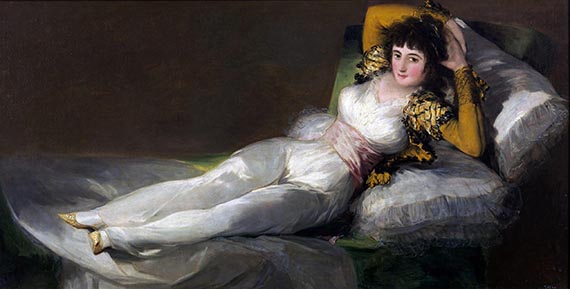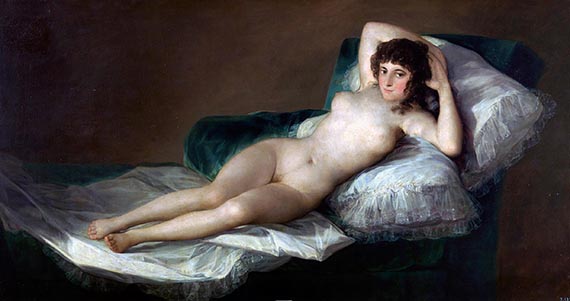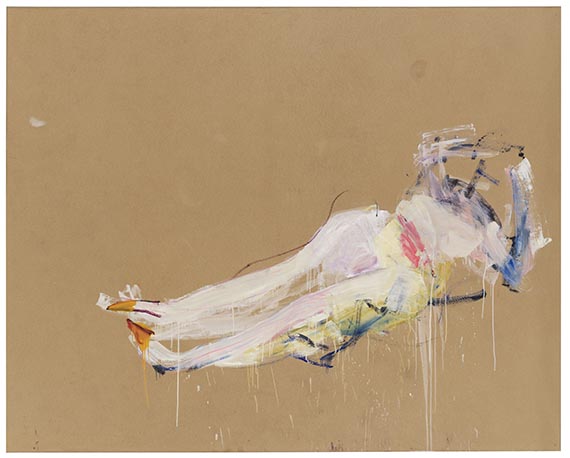Video
46
Martha Jungwirth
Untitled (Maja I), 2021.
Oil on paper, on canvas
Estimate:
€ 200,000 / $ 232,000 Sold:
€ 361,200 / $ 418,992 (incl. surcharge)
Martha Jungwirth
1940
Untitled (Maja I). 2021.
Oil on paper, on canvas.
Signed and dated in the lower left. 238.8 x 299.6 x 2.7 cm (94 x 117.9 x 1 in). [CH].
• Monumental work from a group of three paintings.
• Martha Jungwirth conceived an abstract interpretation of the world-famous portraits “La Maja Vestida” and “La Maja Desnuda” (Museo del Prado, Madrid) by the Spanish painter Francisco de Goya (1746–1828).
• In “Maja I,” the artist reduces Goya's clothed Maja, “La Maja Vestida,” to gestural, painterly, curved color gradients reminiscent of the silhouette of the subject, while retaining the sensual qualities of the original painting in a fascinating way.
• In 2022 and 2024, the work featured in major solo exhibitions at the Kunsthalle Düsseldorf and the Museo Guggenheim Bilbao.
• Last year, Jungwirth was ranked among the world's top ten artists with the strongest market development (source: Manager Magazin).
PROVENANCE: Galerie Thaddaeus Ropac, Paris (with the gallery label on the stretcher).
Private collection, Southern Germany (acquired from the above).
EXHIBITION: Martha Jungwirth, Kunsthalle Düsseldorf, September 2-November 20, 2022, p. 218 (double-page illu. on pp. 180f.).
Martha Jungwirth, Museo Guggenheim Bilbao, June 7-September, 2024, p. 128 (double-page illu. on pp. 128f. and the exhibition poster).
1940
Untitled (Maja I). 2021.
Oil on paper, on canvas.
Signed and dated in the lower left. 238.8 x 299.6 x 2.7 cm (94 x 117.9 x 1 in). [CH].
• Monumental work from a group of three paintings.
• Martha Jungwirth conceived an abstract interpretation of the world-famous portraits “La Maja Vestida” and “La Maja Desnuda” (Museo del Prado, Madrid) by the Spanish painter Francisco de Goya (1746–1828).
• In “Maja I,” the artist reduces Goya's clothed Maja, “La Maja Vestida,” to gestural, painterly, curved color gradients reminiscent of the silhouette of the subject, while retaining the sensual qualities of the original painting in a fascinating way.
• In 2022 and 2024, the work featured in major solo exhibitions at the Kunsthalle Düsseldorf and the Museo Guggenheim Bilbao.
• Last year, Jungwirth was ranked among the world's top ten artists with the strongest market development (source: Manager Magazin).
PROVENANCE: Galerie Thaddaeus Ropac, Paris (with the gallery label on the stretcher).
Private collection, Southern Germany (acquired from the above).
EXHIBITION: Martha Jungwirth, Kunsthalle Düsseldorf, September 2-November 20, 2022, p. 218 (double-page illu. on pp. 180f.).
Martha Jungwirth, Museo Guggenheim Bilbao, June 7-September, 2024, p. 128 (double-page illu. on pp. 128f. and the exhibition poster).
With its translucent silhouette, brown toes, and bright pink girdle over her white dress, “Untitled (Maja I)” is reminiscent of Francisco de Goya's “La Maja Vestida” (“The Clothed Maja,” 1800–1807), and not just in terms of its name. The fleshy tones in Martha Jungwirth's two other Maja paintings from this series, which are based on one another, refer, in turn, to Goya's nude version “La Maja Desnuda” (“The Naked Maja,” 1795–1800), which caused a scandal at the time of its creation. Today, both paintings are on display at the Museo del Prado in Madrid. Unlike Goya's models, Jungwirth's “Untitled (Maja I)” is even larger than life and is reminiscent of the Spanish master's boldness in both theme and painting style.


Goya's works provoked outrage at the beginning of the 19th century, leading to his trial by the Spanish Inquisition, the loss of his position as court painter, and the paintings being locked away for decades. At the same time, “La Maja Desnuda” marked a turning point in art history: the work is considered the first profane, life-size female nude in Western painting. Goya uses representational codes usually reserved for mythological Venus figures to depict an ordinary young woman, mainly of the lower class—a Maja who, moreover, provocatively gazes at the viewer. In Jungwirth's interpretation, the motif is abstracted, reduced to gestural brushstrokes, without losing its sensual quality. Jungwirth takes up Goya's gently curved lines and palette, transforming them into modern, physically tangible painting and giving Maja her own unmistakable identity.
Martha Jungwirth, born in Vienna in 1940, still lives and works in her hometown today. From 1956 to 1963, she studied at the University of Applied Arts Vienna, where she later also taught. Her preferred medium is watercolor; from the very start of her career, she has moved between abstraction and figuration. Despite participating in documenta in Kassel several times, she remained distant from the art world for a long time. It was only an exhibition curated by Albert Oehlen in 2010 that marked her late international breakthrough and made her one of the most sought-after international artists.
She describes her works as a diary that traces her physical struggles with the creative process. Her art is driven by emotions and intuitive movements, by a quest for fluidity, transparency, and purity. Jungwirth's “Maja” is thus understood as a homage to Goya, but at the same time becomes a poetic, abstract silhouette that exudes its own sensual quality and captivates the viewer's gaze. [AW]

Francisco de Goya y Lucientes, La maja vestida (The Dressed Maja), 1800–1807, oil on canvas, Museo Nacional del Prado, Madrid.

Francisco Goya y Lucientes, La maja desnuda (The Naked Maja), 1795–1800, oil on canvas, Museo Nacional del Prado, Madrid.
Goya's works provoked outrage at the beginning of the 19th century, leading to his trial by the Spanish Inquisition, the loss of his position as court painter, and the paintings being locked away for decades. At the same time, “La Maja Desnuda” marked a turning point in art history: the work is considered the first profane, life-size female nude in Western painting. Goya uses representational codes usually reserved for mythological Venus figures to depict an ordinary young woman, mainly of the lower class—a Maja who, moreover, provocatively gazes at the viewer. In Jungwirth's interpretation, the motif is abstracted, reduced to gestural brushstrokes, without losing its sensual quality. Jungwirth takes up Goya's gently curved lines and palette, transforming them into modern, physically tangible painting and giving Maja her own unmistakable identity.
Martha Jungwirth, born in Vienna in 1940, still lives and works in her hometown today. From 1956 to 1963, she studied at the University of Applied Arts Vienna, where she later also taught. Her preferred medium is watercolor; from the very start of her career, she has moved between abstraction and figuration. Despite participating in documenta in Kassel several times, she remained distant from the art world for a long time. It was only an exhibition curated by Albert Oehlen in 2010 that marked her late international breakthrough and made her one of the most sought-after international artists.
She describes her works as a diary that traces her physical struggles with the creative process. Her art is driven by emotions and intuitive movements, by a quest for fluidity, transparency, and purity. Jungwirth's “Maja” is thus understood as a homage to Goya, but at the same time becomes a poetic, abstract silhouette that exudes its own sensual quality and captivates the viewer's gaze. [AW]
46
Martha Jungwirth
Untitled (Maja I), 2021.
Oil on paper, on canvas
Estimate:
€ 200,000 / $ 232,000 Sold:
€ 361,200 / $ 418,992 (incl. surcharge)
Headquarters
Joseph-Wild-Str. 18
81829 Munich
Phone: +49 89 55 244-0
Fax: +49 89 55 244-177
info@kettererkunst.de
Louisa von Saucken / Undine Schleifer
Holstenwall 5
20355 Hamburg
Phone: +49 40 37 49 61-0
Fax: +49 40 37 49 61-66
infohamburg@kettererkunst.de
Dr. Simone Wiechers / Nane Schlage
Fasanenstr. 70
10719 Berlin
Phone: +49 30 88 67 53-63
Fax: +49 30 88 67 56-43
infoberlin@kettererkunst.de
Cordula Lichtenberg
Gertrudenstraße 24-28
50667 Cologne
Phone: +49 221 510 908-15
infokoeln@kettererkunst.de
Hessen
Rhineland-Palatinate
Miriam Heß
Phone: +49 62 21 58 80-038
Fax: +49 62 21 58 80-595
infoheidelberg@kettererkunst.de
We will inform you in time.




 Lot 46
Lot 46 
